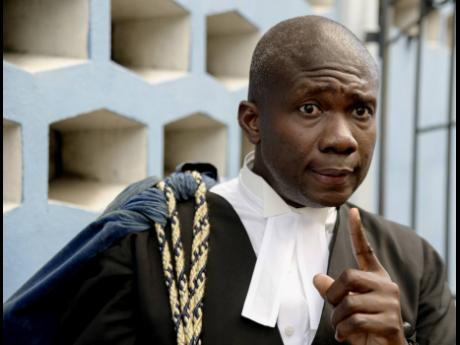Police have no physical evidence of Tonia’s alleged killer
The detective sergeant who led the investigation into Tonia’s McDonald’s murder yesterday disclosed that the police have no physical evidence linking the alleged killer to the woman’s murder.
The policeman also disclosed that nothing was found at Oscar Barnes’ home, in his car, or on his phone to connect him to the gruesome killing.
Except for a statement that was given by confessed contract killer Denvalyn Minott and his identification of the alleged murderer, the senior police officer said the prosecution has nothing else.
The woman’s husband, Everton ‘Beachy Stout’ McDonald, 68, and Barnes, a 33-year-old St Mary tiler, are on trial in the Home Circuit Court for the murder of the 32-year-old businesswoman.
The partially burnt body of Tonia was found on a deserted road along Sherwood Forest in Portland with her throat slashed and multiple stab wounds.
Barnes was arrested in Annotto Bay, St Mary, on August 5, 2020, after he was pointed out by Minott, who said he had been contracted by the woman’s husband to kill her but instead subcontracted the hit job to Barnes.
Minott, a Portland fisherman, pleaded guilty to murder in September 2020 for his role in Tonia’s murder and was sentenced to 19 years in prison with a stipulation that he serve 10 years before parole.
Yesterday during the proceeding, one of Barnes’ lawyers, Vincent Wellesley, who spent the entire day grilling the lead detective, questioned the police’s reliance on Minott’s evidence regarding Barnes after the detective admitted that he had asked Minott in a question-and-answer session why he gave the police three different versions of the murder.
“You knew on August 5 during the Q&A that Minott was not someone you can trust?” Wellesley asked.
But the police witness said that that was not an assumption he made while adding that he could not have known that Minott was unreliable.
“As the investigating officer, didn’t you have cause to suspect him of being a liar?” Wellesley further pressed.
“No,” the detective replied, while indicating that at that time he was still doing his investigation.
Wellesley then asked the witness if he considered himself to be an honest person, to which he replied, “Yes”.
Continuing, the defence lawyer suggested that the detective took his client into custody without exercising good judgment, but the sergeant indicated that doing so was his considered decision.
The lawyer then questioned the investigator about how his client came to be a suspect. The police witness, in reply, said that he had been given certain information, and based on that, Barnes became a suspect.
Wellesley then asked the investigator to share what evidence the police had on his client besides the identification, and accused the officer of being dishonest but was told by the judge to refrain from passing any judgment on the witness’ character.
No description given
The police witness then admitted that although they had got a statement from Minott, it did not contain a description of the person or a name.
Wellesley then enquired further whether the police had collected any evidence from his client’s house or found anything on his phone linking him to the murder and was told no.
The investigator said Barnes’ car was also processed for DNA, but the result was negative.
Meanwhile, later in the hearing, a 1:42-second-long video recording snippet of Minott directing police to Barnes was shown. In the video, a man, not very visible, and said to be Barnes, was seen sitting on a chair on a street corner close to another male who was also sitting on a chair, while two other men walked around.
Wellesley then asked the detective about a question he was heard asking in the video.
The detective earlier had indicated that he was not the person who had asked Minott, “The one inna de bright colour?”
However, the officer claimed that he now realised that he had made an error after seeing the video.
Asked about whether Barnes was in fact the man in the bright-coloured shirt, he said Barnes was in a multicoloured shirt.
Wellesley, however, pointed out that the other person who was sitting on the chair was in a neon green shirt, but the detective insisted that the multicoloured shirt that Barnes was wearing was of a bright colour.
Furthermore, he said, “A spontaneous event requires a spontaneous action, and based on the spontaneous pointing out of Barnes, that was the thought in terms of what came to my mind.”
The police witness who had also earlier testified that he had only seen one person sitting on a chair, after seeing the recording, said that although it was now clear to him that two men were sitting on chairs in the video, at the time when he went there, he only saw Barnes as he was focused on him only.
The trial will continue tomorrow, with Wellesley completing his cross-examination of the lead investigator.

